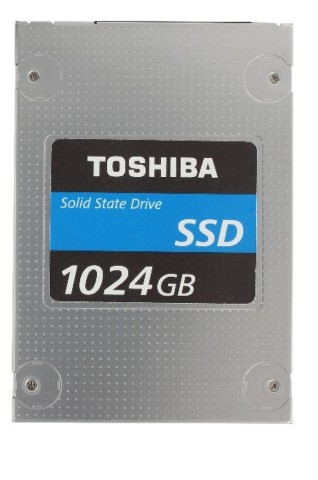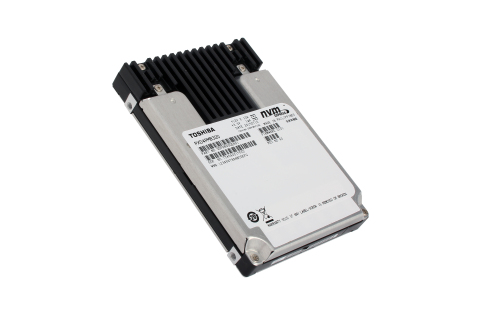TOKYO--(BUSINESS WIRE)--Please replace the release dated August 11, 2015 with the following corrected version due to multiple revisions to the last table.
The corrected release reads:
TOSHIBA UNVEILS THREE NVME SOLID STATE DRIVE FAMILIES
Toshiba’s new line of NVMe, PCIe SSDs leverage low latency and power efficiency to deliver high SSD performance
Toshiba Corporation’s (TOKYO:6502) Semiconductor & Storage Products Company today announced three distinct families of PCIe® (Peripheral Component Interconnect Express) solid state drive (SSD) products using NVMe™ (Non-Volatile Memory Express) protocol, targeted for various applications including high performance notebooks; thin notebooks, 2-in-1/convertible notebooks and tablets; and server and storage applications. All three SSD product lines are optimized for high performance and low latency and utilize the PCIe interface, which provides point-to-point links with the processor, reducing system bottlenecks. Each SSD family is designed for its target segment with capacity, optimized form factor, and security capabilities. Samples of the Toshiba’s newest lines of NVMe, PCIe SSDs will be available from the fourth quarter (Oct. to Dec.) of 2015.
High Performance Notebooks: The XG3 family of SSDs is the industry’s highest capacity[1] (1024GB)[2] client NVMe SSD available in M.2 Type 2280 form factor and optimally designed for high performance notebooks, 2-in-1 PCs and all-in-one PCs. The XG3 in M.2 Type 2280 form factor supports up to four lanes of PCIe 3.1, which has a maximum interface bandwidth more than six times that of SATA 6Gbits/s[3]. XG3 is also the industry’s first NVMe SSD available in 2.5-inch SATA express form factor. The XG3 SSD family is equipped with Toshiba’s proprietary QSBCTM (Quadruple Swing-By Code) error-correction technology, a highly efficient error correction code (ECC), which helps protect customer data from corruption, improves reliability, and extends the life of Toshiba SSDs. Engineered for power efficiency, the XG3 series also features lower power state modes and is the first Toshiba product, along with the BG1 SSD family, to support the Trusted Computing Group specification, Pyrite (TCG Pyrite).
Thin Notebooks and Tablets: The BG1 SSD family is the world’s smallest NVMe SSD[4], available in a single 16mm x 20mm package (M.2 Type 1620) or a removable M.2 Type 2230 module with up to 256GB in capacity. Designed for thin notebooks, 2-in-1/convertible notebooks and tablets, the BG1 family enables PC OEMs to produce thin mobile PCs and tablets while offering a better performing alternative over SATA SSDs for mobile PCs. The BG1 SSD family supports TCG Pyrite and features lower power state modes.
Servers and Storage Appliances: The PX04P SSD family is designed for servers and storage appliances needing scalable power and performance settings. The PX04P series NVMe SSD has the industry’s lowest power consumption[5]. With only 18 watts active power driving maximum performance, with scalable power/performance down to 12watts. The PX04P family also supports up to four lanes of PCIe 3.0, and is available in either a HHHL (half-height half-length) add-in card or a 2.5-inch form factor with SFF-8639 connector. The PX04P SSD family is also equipped with Toshiba’s QSBC error-correction technology.
Toshiba will continue strengthening its SSD lineup, meeting the various needs of users and leading the continuously expanding SSD market.
Outline of the New Products
|
XG3 Series |
||||||||||
| Form Factor | 2.5-type 7.0 mmH |
M.2 Type 2280
(Single side) |
M.2 Type 2280
(Double side) |
|||||||
| Model Name |
Non-SED
Model |
THNSN5xxxGCJ7 (128/256/512 GB)
THNSN51T02CJ7 (1024 GB) |
THNSN5xxxGPU7 | THNSN51T02DU7 | ||||||
| Connector Type | SATA Express | M.2 M | M.2 M | |||||||
| Capacity | 128/256/512/1024 GB | 128/256/512 GB | 1024 GB | |||||||
| Performance[6] |
Sequential Read (Max.): 2400 MiB/s[7] {2516 MB/s}
Sequential Write (Max.): 1500 MiB/s {1572 MB/s} |
|||||||||
| Interface | PCI Express Base Specification Revision 3.1 (PCIe) | |||||||||
| Maximum Speed | 16 GT/s[8] (PCIe Gen3x2 Lane) | 32 GT/s (PCIe Gen3x4 Lane) | ||||||||
| Command | NVM Express Revision 1.1b (NVMe) | |||||||||
| Size | L | 100.0 mm | 80.00 mm | 80.00 mm | ||||||
| W | 69.85 mm | 22.00 mm | 22.00 mm | |||||||
| H | 7.00 mm | 2.15mm | 3.50mm | |||||||
|
BG1 Series |
||||||||||
| Form Factor |
M.2 Type 1620
Single Package |
M.2 Type 2230
(Single side) |
M.2 Type 2280
(Single side) |
|||||||
| Model Name |
Non-SED
Model |
THNSNNxxxGTY7 | THNSNNxxxGSX7 | THNSNNxxxGVX7 | ||||||
| Connector Type | - | M.2 B-M | M.2 B-M | |||||||
| Capacity | 128/256 GB | |||||||||
| Performance[9] |
Sequential Read (Max.): 715 MiB/s {750 MB/s}
Sequential Write (Max.): 228 MiB/s {240 MB/s} |
|||||||||
| Interface | PCI Express Base Specification Revision 3.0 (PCIe) | |||||||||
| Maximum Speed | 10 GT/s (PCIe Gen2x2 Lane) | |||||||||
| Command | NVM Express Revision 1.1a (NVMe) | |||||||||
| Size | L | 20.0 mm | 30.0 mm | 80.0 mm | ||||||
| W | 16.0 mm | 22.0 mm | 22.0 mm | |||||||
| H |
1.4 mm (128GB)
1.65mm (256GB) |
2.2 mm (128GB)
2.45mm (256GB) |
2.2 mm (128GB)
2.45mm (256GB) |
|||||||
|
PX04P Series |
||||||||
| Form Factor | 2.5-type 15 mmH | Add-In Card | ||||||
| Model Name |
Non-SED
Model |
PX04PMB080 / PX04PMB160 / PX04PMB320 |
PX04PMC080 / PX04PMC160 /
PX04PMC320 |
|||||
| Capacity | 800/1600/3200 GB | |||||||
| Performance |
Sequential Read (Max.): 3100 MiB/s {3250 MB/s}
Sequential Write (Max.): 2350 MiB/s {2464 MB/s} |
|||||||
| Interface | PCI Express Base Specification Revision 3.0 (PCIe) | |||||||
| Maximum Speed | 32 GT/s (PCIe Gen3 x 4 Lane) | |||||||
| Command | NVM Express Revision 1.0e (NVMe) | |||||||
| DWPD[10] | 10 | |||||||
| Size | L |
100.45mm |
167.52mm |
|||||
| W | 69.85mm |
18.73mm |
||||||
| H |
15.0mm |
68.77mm |
||||||
*The product specifications are subject to change without notice.
*The
part of “xxx” indicates the capacity of each model (e.g. 256: 256GB)
*PCIe and PCI Express are registered trademarks of PCI-SIG.
*NVMe
and NVM Express are trademarks of NVM Express, Inc.
*QSBC is a
trademark of Toshiba Corporation.
Notes:
[1] As of August 11, 2015, Toshiba survey.
[2]
Definition of capacity: Toshiba defines a megabyte (MB) as 1,000,000
bytes, a gigabyte (GB) as 1,000,000,000 bytes and a terabyte (TB) as
1,000,000,000,000 bytes. A computer operating system, however, reports
storage capacity using powers of 2 for the definition of 1GB = 230 =
1,073,741,824 bytes and therefore shows less storage capacity. Available
storage capacity (including examples of various media files) will vary
based on file size, formatting, settings, software and operating system,
such as Microsoft Operating System and/or pre-installed software
applications, or media content. Actual formatted capacity may vary.
[3]
Read and write speed may vary depending on the host device, read and
write conditions, and file size.
[4] As of August 11, 2015, Toshiba
survey.
[5] As of August 11, 2015, Toshiba survey.
[6] The
performance is of the M.2 Type 2280(1024GB), measured using 128KiB unit
sequential access. The performance varies according to form factor and
capacity.
[7] Toshiba defines a mebibyte (MiB) as 1,048,576 bytes (220).
[8]
Giga Transfers per second. It expresses the transfer speed for only
effective data.
[9] The performance is of the M.2 Type 2230(256GB),
measured using 128KiB unit sequential access. The performance varies
according to form factor and capacity.
[10] DWPD: Drive Write Per
Day.
Follow this link for more on Toshiba SSDs.
http://toshiba.semicon-storage.com/ap-en/product/storage-products.html
Customer Inquiries:
* XG3 Series and BG1 Series:
cSSD Sales &
Marketing Department
Tel: +81-3-3457-3432
* PX04P Series:
Storage
Products Division
Tel: +81-3-3457-2445
Information in this document, including product prices and specifications, content of services and contact information, is current on the date of the announcement but is subject to change without prior notice.
About Toshiba
Toshiba Corporation, a Fortune Global 500 company,
channels world-class capabilities in advanced electronic and electrical
product and systems into five strategic business domains: Energy &
Infrastructure, Community Solutions, Healthcare Systems & Services,
Electronic Devices & Components, and Lifestyles Products & Services.
Guided by the principles of The Basic Commitment of the Toshiba Group,
“Committed to People, Committed to the Future”, Toshiba promotes global
operations towards securing “Growth Through Creativity and Innovation”,
and is contributing to the achievement of a world in which people
everywhere live in safe, secure and comfortable society.
Founded in Tokyo in 1875, today’s Toshiba is at the heart of a global
network of over 590 consolidated companies employing over 200,000 people
worldwide, with annual sales surpassing 6.5 trillion yen (US$63 billion).
To
find out more about Toshiba, visit www.toshiba.co.jp/index.htm






